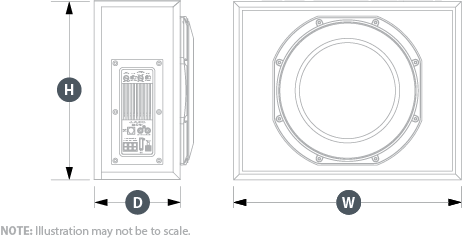JL Audio (ACS112LG-TW1) - Single 12TW1 PowerWedge+ with
DCD Amplifier, Sealed, .25 Ohm
Description:
Amplified Subwoofer System with Single 12TW1-0.25
Subwoofer Driver, Built-In 400W Class D Amplifier, Black
Carpet - Sealed Enclosure
In PowerWedge+ systems, the power is built right into the
subwoofer system. Housing a proprietary Class D
amplifier, this subwoofer system employs JL Audio's
exclusive DCD amplifier technology to extract maximum
output from its specially engineered, ultra low-impedance
TW1 driver. By combining direct power conversion with an
ultra-high current output section, DCD amplifiers are
free of conventional switching power supplies, enabling
them to generate remarkable power with unprecedented
efficiency.
Harnessing the performance and insanely small box
requirements of the TW1 subwoofer driver, this subwoofer
system is designed to deliver amazing sub-bass from an
enclosure that is only 6.625 in. (168 mm) deep. Its
low-profile enclosure design has been carefully
engineered to the optimum sealed enclosure alignment for
the 12TW1 driver and has been fine-tuned through
extensive real-world listening.
Integration to OEM and aftermarket head units is a snap
thanks to a variety of input options and automatic
turn-on capability (via signal sensing or DC offset
sensing). Also included is a variable frequency low-pass
filter (50-200 Hz), along with output polarity control
switch. Adding an optional RBC-1 remote level control
(sold separately) lets you control subwoofer levels
directly from the driver's seat. A quick-disconnect
power connector makes it easy to remove the subwoofer
when you need the extra space.
Note: DCD amplified systems use very specific components.
Never use a DCD amplifier or its companion subwoofer(s)
with incompatible, non-DCD products. Doing so will void
the warranty and may cause severe damage.
Finish: Black, high-grade automotive carpet with silver
"JL AUDIO Built In USA" embroidery on front
baffle. A steel mesh grille is included to protect the
subwoofer driver.
Construction: CNC-Cut High-Grade MDF
Amplifier power: Built-in DCD Class D amplifier (400 W @
0.25 Ohm) Nominal Impedance: 0.25 Ohm
Enclosure and Subwoofer Made in USA
Technology:
DCD Amplifier Technology
The most efficient subwoofer amplifier technology on the
market delivers impressive power with minimal current
draw and heat.
The conventional way to get high power in a car amplifier
is to use a switching power supply. This increases the
battery voltage from its nominal 12V to something
higher-the more powerful the amplifier, the greater the
required voltage. This power conversion is never
perfectly efficient-about 10% of what goes into the
amplifier is wasted and ends up dissipating into heat.
JL Audio's Direct Conversion Class-D Technology (DCD)
innovates by eliminating the need for this power
conversion step entirely. Because JL Audio is still bound
by the laws of physics, the lack of a step-up power
supply means they have to extract as much power as
possible from the vehicle's 12V supply. If JL Audio
were to connect a DCD amplifier to a conventional 4-ohm
subwoofer with this limitation in place, they would only
achieve about 25 watts, and we all know that powering a
subwoofer requires a lot more power than this.
To overcome this obstacle, the DCD amplifiers have been
designed to drive extremely low impedance speaker
loads-as low as 1/4-ohm (0.25 ohm)! With these very low
impedance loads, JL Audio can deliver up to 500 watts of
clean power, subwoofer power. Those who know Ohm's
law and that nothing is free realize that this will
require a lot of current to flow, and that's exactly
what DCD is engineered to deliver...over 50 Amps peak
into a speaker!
To deal with these high current amounts, the special,
very low-impedance JL Audio subwoofer drivers used with
DCD amplifiers are engineered with unique voice coils and
tinsel leads. Connections between the amplifier and
speaker are made using special heavy gauge speaker cable,
with special attention paid to connection integrity to
deal with the high current output.
The benefit of all this effort is that DCD amplifiers
completely avoid the losses associated with a switching
power supply, allowing the entire amplifier to achieve
total power efficiencies in the 91-94% range. This is
very close to the theoretical limit for Class-D
efficiency and results in very little heat being
generated. All of this allows for a very compact,
powerful amplifier that can fit in some of JL Audio's
most space-efficient enclosed systems.
V-Groove MDF Construction
This advanced cabinet-building technique uses
CNC-machining to create precise panel joints that make
enclosure assembly more efficient and exact.
JL Audio begins with quality medium-density fiberboard,
which is then machined on their CNC-controlled KOMO
woodworking stations. These powerful machines are able to
cut a wide range of features onto a sheet of MDF, with
minimal waste and absolute precision. The KOMO machines
cut out the woofer holes, terminal holes, cut dado
grooves, create countersinks and most importantly, cut
the angles at the edges of the panels that form the
enclosure's main shell so that these panels fit
together precisely, with no gaps or leaks.
Once the panels are cut, assembly technicians line them
up in the correct order and glue their outer faces onto a
long piece of carpet, creating a "wrap": a long
series of panels, hinged temporarily by the carpet. In
the next assembly step, their wood assembly teams fill
the V-grooves between the panels and any dado grooves
that receive dividers or secondary wraps with wood-glue.
Once the glue is applied, the enclosure shells folds
together along the V-grooves, capturing dividers in the
dado grooves and secondary wraps, and evenly spreading
the glue throughout the joints. One line of mechanical
fasteners is applied to hold the structure together while
the wood glue dries.
The V-groove technique greatly improves assembly
efficiency, and also results in a far stronger and better
sealed enclosure than the typical butt-joint construction
found on imported enclosures. The quality of the MDF used
in JL Audio systems is also vastly better than the
typical "China-Grade MDF" used in the imported
products.
Dynamic Motor Analysis - DMA Optimized Motor
JL Audio's proprietary Dynamic Motor Analysis system
is a powerful suite of FEA-based modeling systems, first
developed by JL Audio in 1997 and refined over the years
to scientifically address the issue of speaker motor
linearity. This leads to vastly reduced distortion and
faithfully reproduced transients... or put simply: tight,
clean, articulate bass.
Since 1997, JL Audio has been at the forefront of Finite
Element Analysis-based modeling of loudspeaker motors and
suspensions. This research is aimed at decoding what we
refer to as the "Loudspeaker Genome"... a
project aimed at understanding the true behavior of
loudspeakers under power and in motion. A major component
of this integrated system is DMA (Dynamic Motor
Analysis). Starting with the 15W3 and the W7 Subwoofers
in the late 1990's and early 2000's, DMA has
played an important role in the design of all JL Audio
woofers sold today, including their component woofers.
DMA is a Finite Element Analysis (FEA)-based system,
meaning that it takes a large, complex problem, breaks it
down into small solution elements for analysis and then
assembles the data to form an accurate,
"big-picture" solution. DMA's breakthrough
is that it actually considers the effects of power
through the coil as well as coil/cone position within the
framework of a time-domain analysis. This gives them a
highly accurate model of a speaker's actual behavior
under real power, something that the traditional
Thiele-Small models or other low power measurements
cannot do. Because DMA does not rely on a steady-state
model, it is able to consider shifts in the circuit
elements being analyzed. These modeling routines are
intense, requiring hours to run for a whole speaker.
DMA is able to analyze the real effects of fluctuating
power and excursion upon the magnetic circuit of the
motor, specifically the dynamic variations of the
"fixed" magnetic field. This delivers intensely
valuable information compared to traditional modeling,
which assumes that the "fixed" field produced
in the air gap by the magnet and the motor plates is
unchanging. DMA not only shows that this
"fixed" field changes in reaction to the
magnetic field created by current flowing through the
voice coil, but it helps JL Audio's engineers arrive
at motor solutions that minimize this instability.
Analyzing this behavior is critical to understanding the
distortion mechanisms of a speaker motor and sheds light
on the aspects of motor design that determine truly
linear behavior:
- 1. Linear motor force over the speaker's
operational excursion range
- 2. Consistent motor force with both positive and
negative current through the coil
- 3. Consistent motor force at varying applied power
levels
Engineered Lead-Wire System (U.S. Patent
#7,356,157)
Carefully engineered lead-wire design and attachments
ensure controlled, quiet lead-wire behavior under the
most extreme excursion demands.
The payoff is reduced distortion, improved transient
performance and stellar sound quality.
Managing the lead-wires on a long-excursion woofer is one
of the trickier aspects of its mechanical design. To
address this, many long-excursion woofers today rely on a
simple solution that weaves the lead-wires into the
spider (rear suspension) of the driver.
The biggest problem with this approach is that spider
limiting behavior plays a hugely important role a
woofer's performance. Lead-wires that are attached or
woven into the spider material can alter the spider's
"stretching" behavior. The tinsel wire
naturally has less 'give' than the fabric
material of the spider leading to asymmetrical spider
behavior and non-uniform stress distribution around the
spider circumference. The wire attachment points can also
cause localized pulling and tearing forces at the
spider's excursion limits. As such, longevity becomes
a major concern and makes the woven-in design less than
ideal for very long-excursion designs.
While a traditional 'flying lead' design does not
compromise spider linearity or radial stability, it
creates its own challenges on a long-excursion woofer.
Managing the 'whipping' behavior of the wire and
making sure it does not contact the cone or spider is one
challenge. Another is ensuring that the leads do not
short one another or the frame of the woofer.
To overcome these issues, JL Audio's engineered
flying lead-wires work in conjunction with carefully
engineered entry and exit support structures molded into
the terminals and the voice coil collar. Some models also
feature jacketed lead-wires to further reduce the
likelihood of shorting and fatigue. The result is
flawless high-excursion lead-wire behavior, with
outstanding reliability and none of the compromises
inherent to a woven-in lead wire system. Building woofers
this way requires much more labor and parts complexity
than the simpler woven-in approach, but the payoff is in
reduced distortion, reduced mechanical noise and improved
reliability.
Tab-Ear Frame Design
This frame design feature facilitates mounting the
subwoofer driver in tight spaces.
By employing a tab-ear mounting system, the driver's
overall outside dimensions are reduced, permitting it to
be mounted in a space that is very similar to that
required by the next smaller round woofer frame.
Concentric Tube Suspension (U.S. Patent #5,734,132 &
#6,095,280)
JL Audio's patented Concentric Tube Suspension
technology delivers unprecedented excursion in a
low-profile woofer.
The biggest challenge in any low-profile woofer design is
to create enough mechanical clearance for the speaker to
generate enough excursion to meet its output and
low-frequency extension goals. Since these goals were
very ambitious in the development of JL Audio's low
profile woofers, achieving them required development of a
new suspension architecture.
JL Audio's patented solution employs a molded
structure which spans over the edge of the motor system,
supporting the spider on the outside of the motor's
boundaries and the large diameter voice coil on the
inside. The large diameter voice coil permits the magnet
to sit inside it, rather than surrounding the coil as is
typical in most woofers.
The concentric tube structure and the elimination of a
conventional top-plate helps JL Audio place the motor
system higher up into the cone body's space to
further compress depth, while still permitting excellent
mechanical excursion.
Precision Built in U.S.A.
JL Audio's Miramar, Florida loudspeaker production
facility is one of the most advanced in the world.
At a time when most audio products are built overseas, JL
Audio's commitment to in-house loudspeaker production
continues to grow. All W7's, W6's, TW5's,
TW3's, TW1's, W3v3's and some of JL
Audio's ZR products. JL Audio also build their Marine
Speaker Systems, Home Subwoofers, Stealthbox products and
the vast majority of their enclosed subwoofer systems in
Florida.
To pull this off in a competitive world market, JL
Audio's production engineering team has created one
of the world's most advanced loudspeaker assembly
facilities. This commitment to state-of-the-art
technology allows their highly skilled workforce to
efficiently build JL Audio products to extremely high
quality standards.
While it is also feasible to build good quality products
overseas (and JL Audio does build some of their products
in Europe and Asia), it can be challenging when the
product's technology is innovative or complex. Since
most of JL Audio's premium loudspeakers incorporate
proprietary, patented technologies requiring specific
assembly techniques, JL Audio prefers that the people who
design them have close access to the people manufacturing
them.
JL Audio - Ahead of the curve.
Features and Specifications:
- Amplified Subwoofer System with Single 12TW1-0.25
Subwoofer Driver, Built-In 400W Class D Amplifier, Black
Carpet - Sealed Enclosure
- Continuous Power Handling (RMS) - Built-in amplifier
400 W @ 0.25 Ohm
- System Nominal Impedance - 0.25 Ohm
- Input Voltage Range @ RCA Inputs - 70 mV - 1.40 V RMS
- Input Voltage Range @ High-Level Inputs - 280 mV -
5.4 V RMS
- Recommended Copper Power / Ground Wire Gauge - 8 AWG
wire
- Fuse Rating - 30 A (ATO or ATC)
- Enclosure Type - Slot-ported, Low-profile
- Finish - Black carpet
- Grille Included - Black Steel Mesh
- Filter Mode(s) - Low-Pass only
- Filter Slope(s) - 12 dB/octave
- Filter Frequency Range - 50 Hz - 200 Hz
- Output Polarity Switch - Yes
- Remote Subwoofer Level Control - Optional (RBC-1)
- UPC 0699440933353
- Color: Black
- Manufacturer's Limited Warranty - 2 Year(s)
- Sold: Each

ACS112LG-TW1 - Physical Specifications
|
|
External Width (W)
|
21 in / 533 mm
|
|
External Height (H)
|
13.5 in / 343 mm
|
|
External Depth (D1)
|
6.625 in / 168 mm
|
|
Net Weight
|
29.2 lb / 13.24 kg
|
|
The ACS112LG-TW1
Product Manual
JL Audio (ACS112LG-TW1) - Single 12TW1 PowerWedge+ with
DCD Amplifier
Please Note:
- This Selection Is JL Audio (ACS112LG-TW1) ONLY.
- Manufacturer's product specifications,
packaging and limited warranties (if applicable) are
subject to change.
- Images are solely for illustrative purposes and may
reflect multiple items or multiple views of a single
item.
- This Item Is Sold: Each

 Please sign our guest book.
Please sign our guest book. Join us on gab!The home of free speech online.
Join us on gab!The home of free speech online.